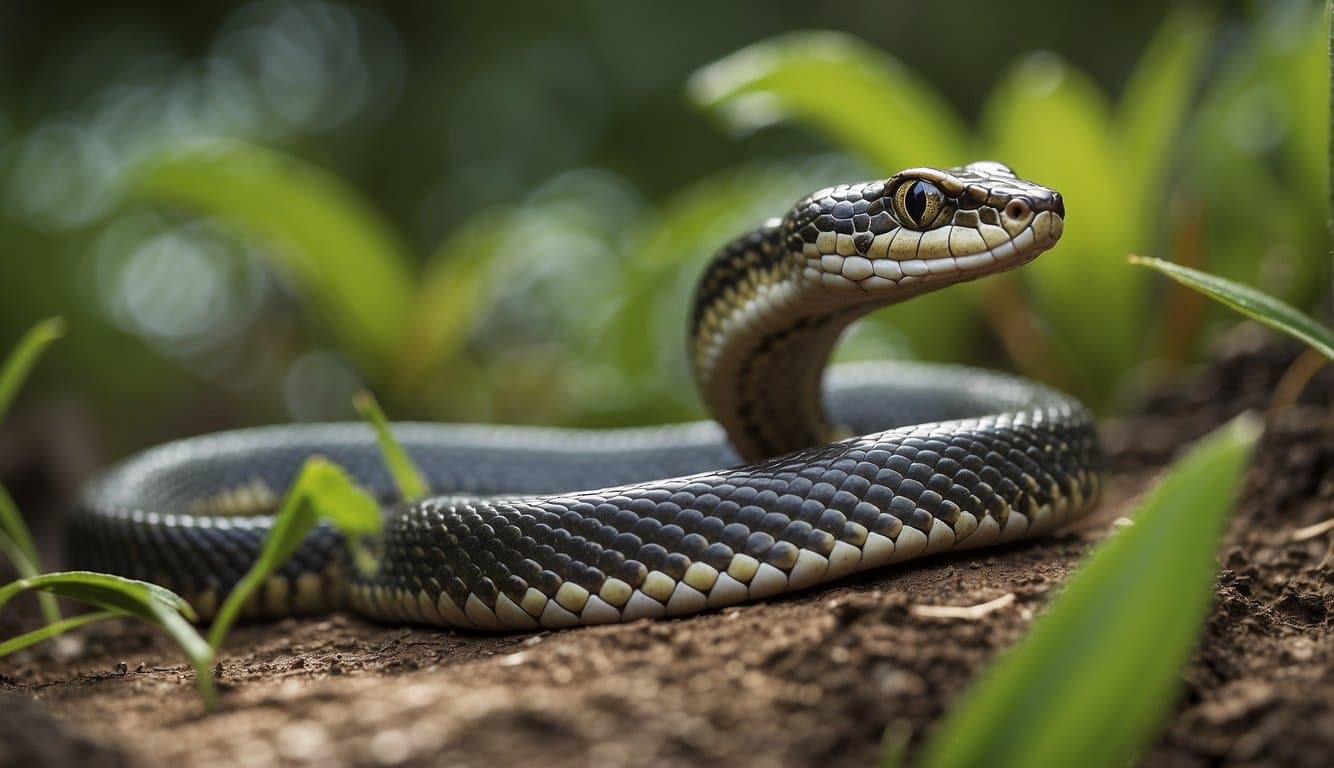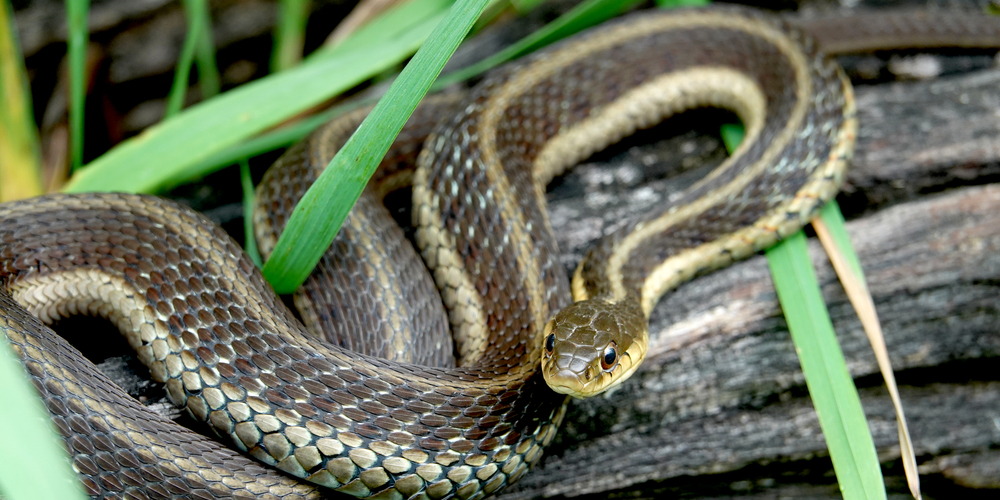For this article, the terms “garden” and “Garter” are interchangeable.
Garden snakes, often referred to as garter snakes, are common in many parts of North America and have a diet that reflects their environment and available prey. Here’s a table summarizing their dietary habits:
| Question | What Do Garden Snakes Eat? |
|---|---|
| Answer | A Varied Diet |
| More Info | Garden snakes are carnivorous and consume a wide range of prey. They typically eat:
|
These snakes are opportunistic feeders and will generally eat anything they can easily overpower, making them beneficial for controlling pest populations in gardens.
Dietary Habits of Garden Snakes
Garden snakes, often referred to as garter snakes, have a varied diet that supports their role in maintaining a balanced ecosystem. Your understanding of their feeding routines can be quite intriguing, as they exhibit flexible dietary preferences.
- Diversity in Diet:
- Insects are a staple, with garden snakes preying on grasshoppers, crickets, and beetles.
- They also consume rodents such as mice, although this is a less common part of their diet.
- Aquatic Menu:
Near water sources, they show a pescatarian side by including fish, leeches, and tadpoles in their meals.
- Amphibian Fare:
They aren’t turned off by the slimy texture of amphibians; frogs, toads (immune to their toxins), and salamanders are all on the menu.
- Frequency and Environment:
Your garden snake’s appetite is influenced by the temperature; they may eat more or less often depending on how warm their environment is. During colder periods, expect their eating frequency to drop.
Common Prey and Hunting Techniques
Garden snakes, often known as garter snakes, have a varied diet and employ several effective strategies to capture their prey. Your garden could be a buffet to them, depending on what prey resides there.
Insects and Arthropods
- What They Eat:
- Garden snakes feast on these smaller creatures with unmatched zeal. They are particularly good at controlling pest populations in your backyard.
-
- Slugs
- Leeches
- Earthworms
- Ants
Amphibians and Reptiles
- Prey Items:
- Your garden snake uses ambush techniques to snag these quick-moving prey, helping balance the local ecosystem.
-
- Frogs and tadpoles
- Toads
- Small lizards
Rodents and Small Mammals
- Typical Meals:
- Garden snakes aren’t your typical predators; they play a crucial role by keeping the population of these small creatures in check.
-
- Mice
- Voles
Feeding Frequency and Behavior
- Frequency: Garden snakes may eat several times a week, depending on the availability of prey.
- Behavior: They utilize stealth and speed, striking with precision to secure their meal.
What Affects Their Diet
In determining what garden snakes prey on, several factors come into play that alter their menu. These include the time of year, their environment, and their development stage.
Seasonal Variations
- During warmer seasons, your garden snake has a veritable buffet of prey items as the easier access to food sources like rodents and insects becomes available.
- When it’s cold, snakes are less active and therefore have a lower caloric requirement, often resulting in a period of dormancy.
Habitat Influence
- If your garden snake resides in or near wild areas, it’s likely to consume a diet heavy in amphibians and fish.
- Snakes in these regions may have more encounters with rodents and may adapt to a more rodent-rich diet.
Snake Age and Size
- Younger and smaller snakes will often target smaller and more abundant prey such as insects and small amphibians.
- As garden snakes grow, your slithery friends are not shy about graduating to larger prey, including rodents and sometimes even birds, depending on their size.
Garden Snakes Add a Ton of Value to Your Ecosystem
Garden snakes, or garter snakes, provide significant ecological benefits that directly impact your garden’s health:
- Natural Pest Control: These slender, fast-moving reptiles are expert pest managers. They prey on a variety of animals that may be harmful to garden plants, such as:
- Slugs
- Grubs
- Insects
- Prey Balance: By consuming a multitude of pests, garden snakes help maintain a balanced food web. This ensures that no single pest population becomes overly dominant, which can lead to plant damage.
- Soil Aeration: As garden snakes move and hunt through soil and underbrush, they inadvertently aerate the soil. This allows for better water infiltration and root growth.
- Biodiversity Support: Garden snakes are a key component of garden biodiversity. They represent both a predator and a prey species in the food chain. For example, they may become food for larger predators such as birds of prey, thus contributing to the diverse trophic interactions that sustain ecosystem health.
Human Impact on Garden Snake Diet
Your actions can alter the diet of garden snakes significantly. These small reptiles are common in North American ecosystems, where they play a crucial role in controlling pest populations. Here’s how your presence affects their eating habits:
Garden Maintenance:
- Pesticides and herbicides can reduce insect populations that garden snakes prey upon.
- Regular lawn mowing can destroy the habitat for both the snakes and their prey.
- Cultivating gardens with native plants encourages insect diversity, which can contribute to a richer diet for garden snakes.
Interaction with Wildlife:
- Cats and dogs may hunt garden snakes, disrupting their hunting and feeding routines.
- Providing food for birds or other animals can attract prey species that garden snakes may eat.
Waste and Pollution:
- Discarded trash can trap or harm garden snakes, affecting their ability to hunt.
- Chemical runoff into water bodies can impact amphibian species that many garden snakes consume.
Urbanization:
- The conversion of land for development can limit the available foraging grounds for garden snakes.
- Urban areas with less vegetation may have fewer cool, moist areas that snakes and their prey require.
Frequently Asked Questions
When it comes to the diet of garden snakes, several common questions arise due to their varied diet and adaptive nature.
What do baby garter snakes consume?
- Baby garter snakes typically feed on earthworms and small insects such as slugs and grubs. These prey are manageable in size and help the young snakes grow and develop properly.
What is the diet of garden snakes during winter?
- During winter, garden snakes often enter a state of brumation, a hibernation-like state, and they do not actively feed. If they do eat, their consumption is minimal and infrequent.
What comprises the diet and hydration of garden snakes?
- Garden snakes primarily consume small frogs and toads, and they hydrate by drinking water from their environment.
- They also eat earthworms, insects, and small rodents, which provide them with their necessary moisture and nutritional needs.
What is the maximum size garter snakes can attain?
- On average, garter snakes can grow to about two feet in length, though some individuals may reach up to four feet.
How frequently should garter snakes be fed?
- In captivity, adult garter snakes should be fed once every few days to once a week, depending on their size and the temperature of their environment.
Are garter snakes beneficial for garden ecosystems?
- Yes, garter snakes are beneficial for garden ecosystems.
- They help control pest populations, such as insects and rodents, promoting a balanced environment.
Last update on 2024-05-03 / Affiliate links / Images from Amazon Product Advertising API




